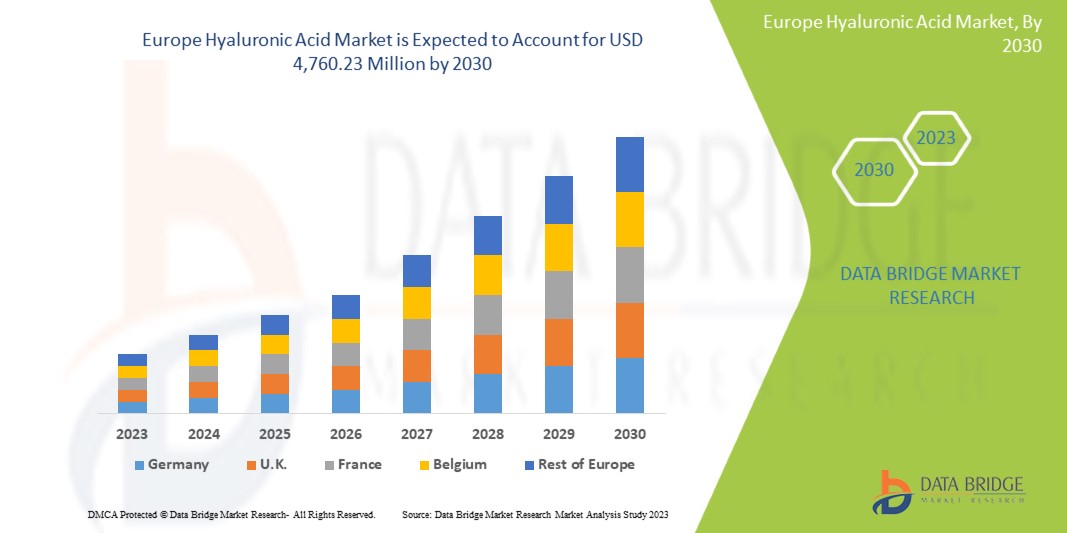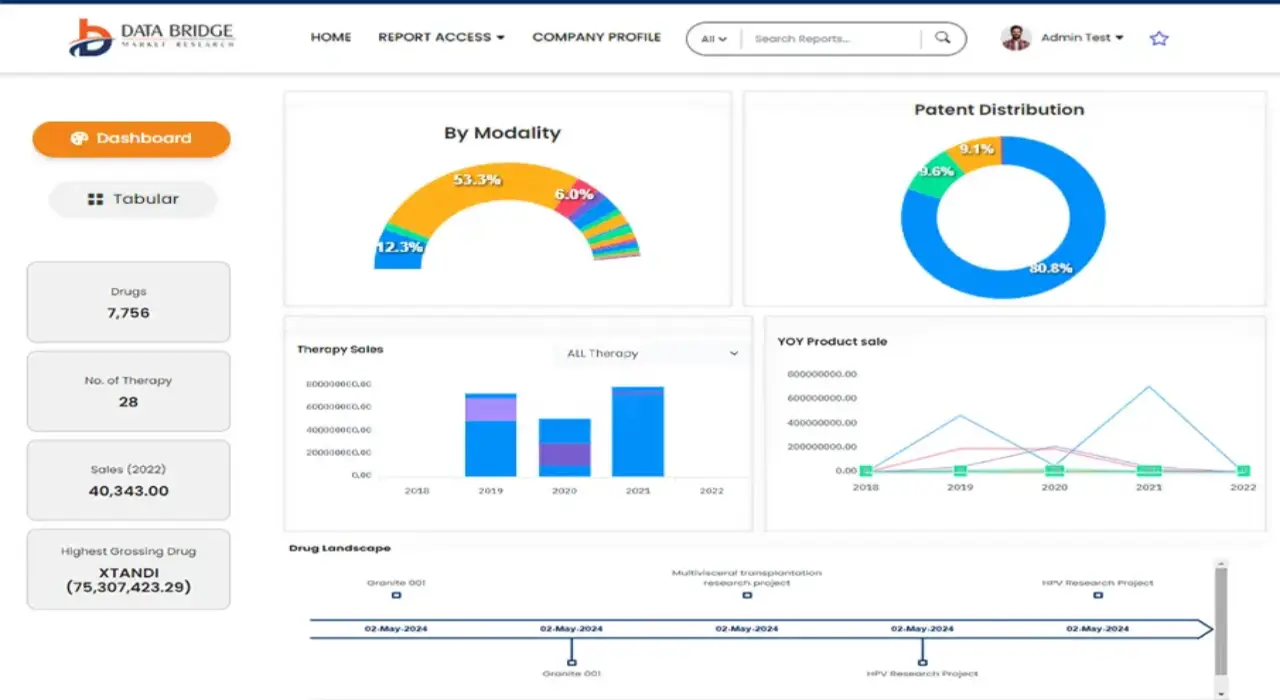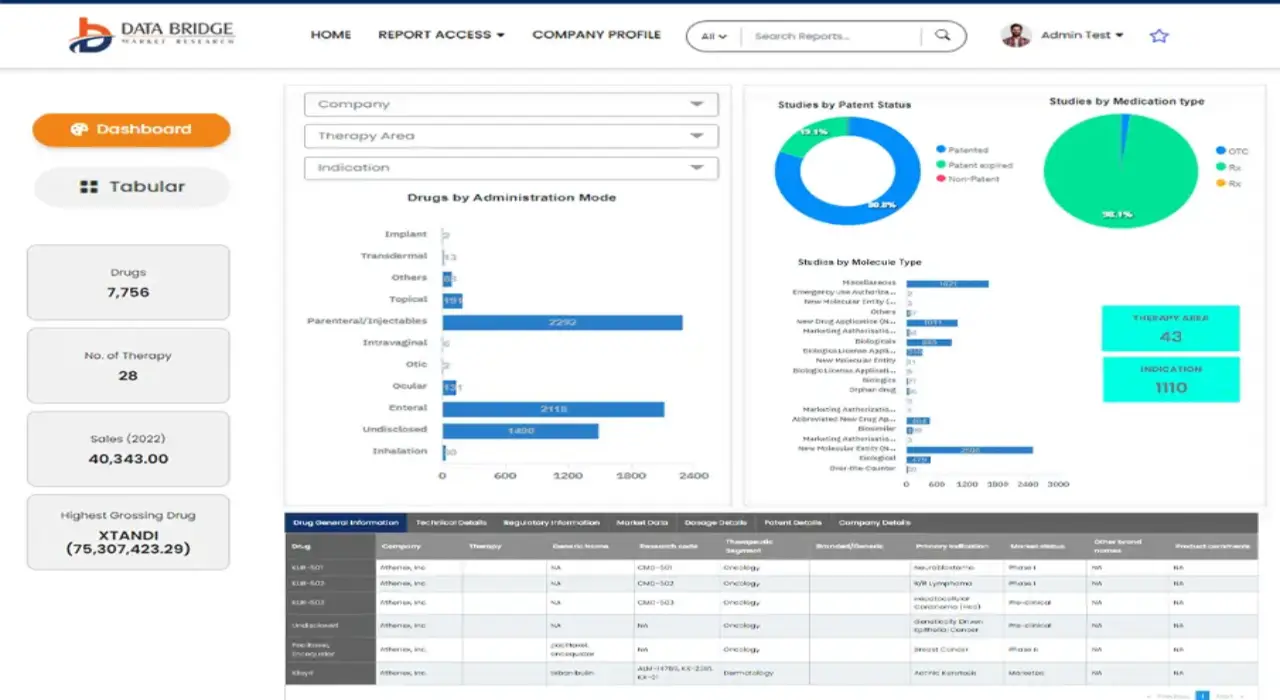Europe Hyaluronic Acid Market
Market Size in USD Billion
CAGR :
% 
 USD
2.48 Billion
USD
4.62 Billion
2024
2032
USD
2.48 Billion
USD
4.62 Billion
2024
2032
| 2025 –2032 | |
| USD 2.48 Billion | |
| USD 4.62 Billion | |
|
|
|
Europe Hyaluronic Acid Market, By Grade (Cosmetic Grade and Pharmaceutical Grade), Type (Sodium Hyaluronate, Hydrolyzed Hyaluronic Acid, and Sodium Acetylated Hyaluronic Acid), Application (Aesthetics, Osteoarthritis, Cosmetics, Ophthalmology, Pharmaceutical API, and Others), End user (Dermatology Clinics, Cosmetic Surgery Centers, Medical Spas and Beauty Centers, and Others), Distribution channel (Retail Sales and Direct Tender), Country (Germany, U.K., Italy, France, Spain, Russia, Switzerland, Turkey, Belgium, Netherlands, and rest of Europe) - Industry Trends And Forecast To 2031
Europe Hyaluronic Acid Market Analysis
Hyaluronic Acid (HA) also called hyaluronan, is an anionic, non-sulfated glycosaminoglycan distributed widely throughout connective, epithelial, and neural tissues. It is a glycosaminoglycan with exceptional hydrating properties, capable of holding large amounts of water. In skincare and medical applications, HA is highly valued for its ability to moisturize, plump, and rejuvenate the skin, as well as for its role in promoting joint health and wound healing.
Europe Hyaluronic Acid Market Size
Europe hyaluronic acid market is expected to reach USD 4.62 billion by 2032 from USD 2.48 billion in 2024, growing at a CAGR of 8.06% in the forecast period of 2025 to 2032. In addition to the insights on market scenarios such as market value, growth rate, segmentation, geographical coverage, and major players, the market reports curated by the Data Bridge Market Research also include depth expert analysis, patient epidemiology, pipeline analysis, pricing analysis, and regulatory framework.
Europe Hyaluronic Acid Market Trends
“Growing Demand for Non-Surgical Cosmetic Procedures”
One notable trend in the hyaluronic acid market is the growing demand for non-surgical cosmetic procedures, particularly injectable treatments. As consumers become more aware of aesthetic options that provide visible results without the need for invasive surgery, hyaluronic acid fillers have gained popularity for their ability to enhance facial volume, smooth wrinkles, and improve skin hydration. This trend is fueled by a broader acceptance of cosmetic procedures across various demographic groups, with younger individuals increasingly opting for preventative treatments. Additionally, the introduction of advanced formulations with improved longevity and safety profiles has further driven consumer confidence in these products. As a result, the hyaluronic acid market is witnessing substantial growth, bolstered by the rising popularity of aesthetic enhancements that cater to a diverse client base seeking to achieve youthful, radiant looks with minimal downtime.
Report Scope and Europe Hyaluronic Acid Market Segmentation
|
Attributes |
Europe Hyaluronic Acid Key Market Insights |
|
Segments Covered |
|
|
Countries Covered |
Germany, U.K., Italy, France, Spain, Russia, Switzerland, Turkey, Belgium, Netherlands, and rest of Europe |
|
Key Market Players |
Fufeng group (China), Fidia Farmaceutic S.p.A. (Italy), DSM (Europe), Asahi Kasei Corporation (Japan), Nestle (Europe), AbbIVe Inc. (U.S.), Galderma (Europe), Virchow biotech (India), Givaudan (Europe), Anika Therapeutics, Inc (U.S.), Seikagaku corporation (Japan), Merz North America Inc. (U.S.), Contipro a.s. (Europe), Bloomage Biotech Co., Ltd (China) |
|
Market Opportunities |
|
|
Value Added Data Infosets |
In addition to the insights on market scenarios such as market value, growth rate, segmentation, geographical coverage, and major players, the market reports curated by the Data Bridge Market Research also include depth expert analysis, patient epidemiology, pipeline analysis, pricing analysis, and regulatory framework. |
Europe Hyaluronic Acid Market Definition
The hyaluronic acid market refers to the commercial sector that encompasses the production, distribution, and sale of hyaluronic acid and its derivatives, which are utilized in various applications, including pharmaceuticals, cosmetic treatments, and skincare products. This market has gained significant traction due to the increasing demand for non-invasive aesthetic procedures, the rising prevalence of joint disorders, and the growing awareness of the benefits of hyaluronic acid in enhancing skin hydration and elasticity. Key segments within the market include injectable fillers for facial aesthetics, topical skincare formulations, and medical products for joint pain relief. With continuous advancements in technology and formulations, the hyaluronic acid market is experiencing robust growth, driven by both consumer interest in beauty and wellness as well as clinical applications in healthcare.
Europe Hyaluronic Acid Market Dynamics
Drivers
- Increasing Trends of Hyaluronic acid
The increasing trend of hyaluronic acid (HA) reflects its growing popularity and utilization across various industries. In skincare, HA is prized for its ability to hydrate and plump the skin, reducing the appearance of fine lines and wrinkles, hence its prevalence in moisturizers, serums, and other beauty products. Moreover, the medical field sees HA used in treatments like dermal fillers for cosmetic enhancements and in osteoarthritis therapy to lubricate joints and reduce pain. Its biocompatibility and natural occurrence in the body contribute to its widespread acceptance and use. As research continues to uncover its versatile applications, the demand for HA in both cosmetic and medical sectors is expected to further escalate The increasing prevalence of risk factors such as inactive lifestyles, unhealthy dietary habits, obesity, and aging populations contributes to the growing number of individuals diagnosed with diabetes. With more people living with diabetes, there is a larger market for diabetes management products, including blood glucose test strips. For individuals with diabetes, regular monitoring of blood glucose levels is essential for managing the condition and preventing complications. Blood glucose test strips allow patients to monitor their blood sugar levels at home or on the go, providing valuable information to guide dietary choices, medication dosing, and lifestyle modifications. As diabetes becomes more prevalent, the importance of effective glucose monitoring becomes increasingly recognized, driving the demand for test strips.
- Rising Initiatives by Market Players
Healthcare market players are exhibiting a growing initiative in addressing the challenges of hyaluronic acid (HA) utilization, spurred by increasing demand and awareness of its therapeutic potential. Pharmaceutical companies are intensifying research and development efforts to innovate novel formulations and delivery systems for HA-based treatments, aiming to enhance efficacy and patient outcomes. Additionally, medical device manufacturers are investing in advanced technologies to improve the production and application of HA-based products, expanding their reach across various medical specialties such as orthopedics, ophthalmology, and dermatology. Furthermore, collaborations between industry stakeholders and academic institutions are fostering a deeper understanding of HA's mechanisms of action and its diverse clinical applications, driving forward the development of new treatment modalities. This collective initiative reflects a concerted effort within the healthcare sector to harness the full therapeutic benefits of HA and meet the evolving needs of patients worldwide.
Opportunities
- Increasing Technological Advancements in Hyaluronic Products
The increasing technological advancement in hyaluronic acid (HA) has revolutionized various fields, particularly in medicine and cosmetics. HA, a naturally occurring substance in the body, is renowned for its ability to retain moisture and promote tissue hydration and elasticity. Recent innovations have led to the development of advanced HA-based products with enhanced properties and applications. In medicine, HA is widely used in orthopedics for joint lubrication and cushioning, in ophthalmology for eye surgery, and in dermatology for soft tissue augmentation and wound healing. Moreover, in the cosmetic industry, HA-based dermal fillers and skincare products are gaining popularity for their anti-aging and moisturizing effects. Technological breakthroughs, such as novel manufacturing techniques and molecular modifications, are continuously improving the efficacy, longevity, and safety profile of HA products, paving the way for further advancements and diversified applications in healthcare and beyond
- Integration with other active combinations
Integration of hyaluronic acid with other active components presents a significant opportunity within the hyaluronic acid market, as it allows for the formulation of multifunctional products that address diverse consumer needs. By combining hyaluronic acid with ingredients such as peptides, vitamins, antioxidants, and botanical extracts, formulators can enhance the overall efficacy of skincare and cosmetic products, targeting specific concerns like aging, pigmentation, or hydration. This synergistic approach not only improves product performance but also expands the appeal to consumers seeking comprehensive solutions for skin health and beauty. Additionally, the increasing trend towards personalized skincare regimens further drives the demand for such integrated formulations, positioning hyaluronic acid as a pivotal ingredient in innovative product development that can cater to the evolving preferences of consumers, thus creating a dynamic landscape for growth in the market.
Restraints/Challenges
- Side Effects Associated with Hyaluronic acid
Hyaluronic acid (HA) is a naturally occurring substance found in the body, often used in medical and cosmetic treatments. While generally well-tolerated, side effects can occur, particularly with HA injections for cosmetic purposes. Common side effects include temporary redness, swelling, bruising, and tenderness at the injection site. In rare cases, allergic reactions may occur, manifesting as itching, rash, or difficulty breathing. Additionally, improper injection technique or placement can result in lumps or unevenness in the skin. It's essential to discuss potential risks and benefits with a healthcare professional before undergoing any HA treatment, ensuring a personalized approach and minimizing the risk of adverse effects.
- Safety Concerns with Hyaluronic acid products
Safety concerns related to hyaluronic acid are a significant challenge, particularly given its widespread use in cosmetic and medical applications. While hyaluronic acid is generally considered safe and is naturally present in the human body, potential risks arise from its synthetic or extracted forms used in dermal fillers and other treatments. Adverse reactions can include allergic responses, infections, and granuloma formation, particularly if the substance is not properly purified or administered. Additionally, improper injection techniques can lead to complications such as vascular occlusion, which can cause tissue necrosis and, in severe cases, blindness. Ensuring the safety of hyaluronic acid products thus requires stringent quality control, thorough clinical testing, and professional administration by qualified healthcare providers.
Europe Hyaluronic Acid Market Scope
The market is segmented nine notable segments based on form, grade, and type, route of administration, source, dosage form, application, end user, and distribution channel.. The growth amongst these segments will help you analyze meagre growth segments in the industries and provide the users with a valuable market overview and market insights to help them make strategic decisions for identifying core market applications.
Form
- Native/Linear Hyaluronic Acid
- Cross-Linked Hyaluronic Acid
Grade
- Cosmetic Grade
- Pharmaceutical Grade
- Food Grade
Type
- Sodium Hyaluronate
- Hydrolyzed Hyaluronic
- Sodium Acetylated Hyaluronic Acid
Route of administaratation
- Parenteral
- Topical
- Oral
Source
- Microbial Fermentation
- Animal based
- Plant based
Dosage form
- Powder
- Solution
- Gel
Application
- Aesthetics
- Osteoarthritis
- Cosmetics
- Ophthalmology
- Pharmaceutical API
- Others
End User
- Dermatology Clinics
- Cosmetic Surgery Centers
- Medical Spas and Beauty Centers
- Others
Distribution Channel
- Retail Sales
- Direct Tender
Europe Hyaluronic Acid Market Regional Analysis
The market is analyzed and market size insights and trends are provided by form, grade, and type, route of administration, source, dosage form, application, end user, and distribution channel as referenced above.
The country section of the report also provides individual market impacting factors and changes in regulation in the market domestically that impacts the current and future trends of the market. Data points like down-stream and upstream value chain analysis, technical trends and porter's five forces analysis, case studies are some of the pointers used to forecast the market scenario for individual countries. Also, the presence and availability of Asia-Pacific brands and their challenges faced due to large or scarce competition from local and domestic brands, impact of domestic tariffs and trade routes are considered while providing forecast analysis of the country data.
Europe Hyaluronic Acid Market Share
The market competitive landscape provides details by competitor. Details included are company overview, company financials, revenue generated, market potential, investment in research and development, new market initiatives, Asia-Pacific presence, production sites and facilities, production capacities, company strengths and weaknesses, product launch, product width and breadth, application dominance. The above data points provided are only related to the companies' focus related to market.
Europe Hyaluronic Acid Market Leaders Operating in the Market Are:
- Fufeng group (China)
- Fidia Farmaceutic S.p.A. (Italy)
- DSM (Europe)
- Asahi Kasei Corporation (Japan)
- Nestle (Europe)
- AbbIVe Inc. (U.S.)
- Galderma (Europe)
- Virchow biotech (India)
- Givaudan (Europe)
- Anika Therapeutics Inc (U.S.)
- Merz North America Inc. (U.S.)
- Contipro a.s. (Europe)
- Bloomage Biotech Co. Ltd (China)
Latest Developments in Europe Hyaluronic Acid Market
- In February 2021, Contipro, a renowned hyaluronic acid manufacturer based in the Czech Republic, announced the launch of its new anti-aging and anti-acne treatment product called HyRetin, which improves visibility of the skin
- In April 2019, Merz North America, Inc., announced that HRA Pharma would acquire the Europe rights to the Mederma brand, which includes products across the scar care, stretch marks, and skincare categories. This led the company to a continued strategic focus on aesthetics market
- In December 2021, Allergan announced that the company had completed its acquisition of Soliton, Inc. This has helped the company in expanding its aesthetic product portfolio in the market
SKU-
Get online access to the report on the World's First Market Intelligence Cloud
- Interactive Data Analysis Dashboard
- Company Analysis Dashboard for high growth potential opportunities
- Research Analyst Access for customization & queries
- Competitor Analysis with Interactive dashboard
- Latest News, Updates & Trend analysis
- Harness the Power of Benchmark Analysis for Comprehensive Competitor Tracking
Research Methodology
Data collection and base year analysis are done using data collection modules with large sample sizes. The stage includes obtaining market information or related data through various sources and strategies. It includes examining and planning all the data acquired from the past in advance. It likewise envelops the examination of information inconsistencies seen across different information sources. The market data is analysed and estimated using market statistical and coherent models. Also, market share analysis and key trend analysis are the major success factors in the market report. To know more, please request an analyst call or drop down your inquiry.
The key research methodology used by DBMR research team is data triangulation which involves data mining, analysis of the impact of data variables on the market and primary (industry expert) validation. Data models include Vendor Positioning Grid, Market Time Line Analysis, Market Overview and Guide, Company Positioning Grid, Patent Analysis, Pricing Analysis, Company Market Share Analysis, Standards of Measurement, Global versus Regional and Vendor Share Analysis. To know more about the research methodology, drop in an inquiry to speak to our industry experts.
Customization Available
Data Bridge Market Research is a leader in advanced formative research. We take pride in servicing our existing and new customers with data and analysis that match and suits their goal. The report can be customized to include price trend analysis of target brands understanding the market for additional countries (ask for the list of countries), clinical trial results data, literature review, refurbished market and product base analysis. Market analysis of target competitors can be analyzed from technology-based analysis to market portfolio strategies. We can add as many competitors that you require data about in the format and data style you are looking for. Our team of analysts can also provide you data in crude raw excel files pivot tables (Fact book) or can assist you in creating presentations from the data sets available in the report.













